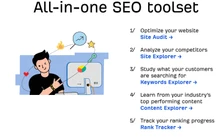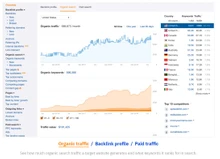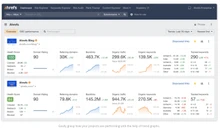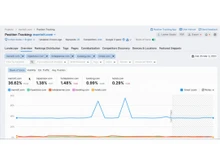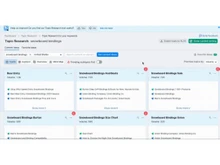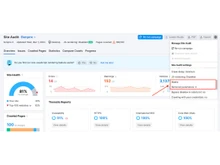Ahrefs vs. Semrush: Choosing the Right SEO and Digital Marketing Tool
Ahrefs and Semrush are two of the most powerful and popular tools in the SEO and digital marketing industry. Both platforms offer a comprehensive suite of features designed to help users improve their website's visibility, analyze their competition, and gain valuable insights into their online performance.
While they share many similarities, they also have distinct strengths and weaknesses that make them better suited for different users and purposes. This guide provides an in-depth comparison of Ahrefs and Semrush, drawing upon the previously conducted SWOT analysis to help you make an informed decision about which tool is right for you.
1. Strengths: A Head-to-Head Comparison
Both Ahrefs and Semrush excel in several key areas, but their specific strengths cater to slightly different aspects of SEO and digital marketing.
Ahrefs:
- Best-in-Class Backlink Analysis: Ahrefs is widely recognized for having the most extensive and accurate backlink database in the industry. Its backlink index is updated frequently, providing users with near real-time data on their own and their competitors' link profiles. This depth of data allows for granular analysis of referring domains, anchor text, and link quality, making it invaluable for link building and competitive intelligence.
- Accurate Keyword Research Data: Ahrefs offers robust keyword research capabilities, providing essential metrics like search volume, keyword difficulty, and traffic potential. Its Keywords Explorer is praised for its extensive database, helping users identify relevant terms and uncover new keyword opportunities. The platform also provides estimates on the number of backlinks needed to rank for a given keyword.
- User-Friendly Interface and Visual Reports: Many users appreciate Ahrefs for its clean, intuitive, and easy-to-navigate interface. The platform is designed to make data accessible, with visually appealing reports that summarize key information effectively. This user-friendliness lowers the learning curve, especially for those new to SEO.
- Strong Site Audit Feature: Ahrefs' Site Audit tool is highly effective in identifying a wide range of technical and on-page SEO issues that can impact a website's search engine rankings. It detects issues like slow-loading content, missing alt text, SSL problems, crawl errors, and duplicate content, providing granular data on affected pages.
- Traffic Potential Metric: A unique strength of Ahrefs is its traffic potential"metric for keywords. This goes beyond standard search volume by estimating the total traffic a top-ranking page could receive for a keyword and its close variations. This provides a more comprehensive understanding of a keyword's value for content planning.
Semrush:
- Comprehensive All-in-One Marketing Platform: Semrush stands out for its extensive suite of over 5 tools and features that cover a wide spectrum of digital marketing, including SEO, PPC, content marketing, social media management, and market research. This integrated approach allows users to manage and analyze various aspects of their online presence from a single platform.
- Large Keyword Database: Semrush boasts a massive keyword database, often cited as larger than Ahrefs', encompassing billions of keywords across numerous global locations. This extensive database facilitates in-depth keyword research, providing metrics like search volume, keyword difficulty, CPC data, and search intent insights.
- Robust PPC and Advertising Analysis Features: Semrush offers a comprehensive toolkit for managing PPC campaigns and conducting in-depth competitor research. Users can analyze competitors' ad strategies, including keywords, ad creatives, and landing pages. This makes Semrush particularly valuable for businesses that rely heavily on paid search.
- Comprehensive Site Audit Tool: Semrush's Site Audit tool is thorough in identifying technical SEO issues that could hinder website rankings. It checks for crawlability, site speed, mobile-friendliness, SSL certificates, duplicate content, and broken links, providing actionable recommendations for improvement.
- Daily Rank Tracking Updates: Semrush offers a significant advantage with its daily updates for keyword rank tracking. This allows users to monitor their keyword positions on a near real-time basis, enabling them to react quickly to any changes in the search engine results pages (SERPs).
2. Weaknesses: Where Each Tool Falls Short
While both platforms are powerful, they also have certain limitations.
Ahrefs:
- Credit-Based Pricing Model: A significant drawback for users on lower-tier plans is Ahrefs' credit-based pricing. Even basic actions like applying filters consume credits, which can quickly deplete the monthly allowance for users with extensive research needs, potentially leading to unexpected extra charges.
- Limited PPC Features: Compared to Semrush, Ahrefs offers limited features for PPC advertising analysis. It lacks the depth of PPC data and tools that Semrush provides, such as detailed ad history and PLA research.
- Weekly Rank Tracking Updates on Lower Plans: Users on Ahrefs' lower-tier plans receive weekly updates for their keyword rank tracking reports. In the dynamic SERP environment, this frequency might not be sufficient for SEO professionals who need to monitor ranking changes more closely.
- Inaccurate Traffic Statistics in Some Cases: Some users have reported that Ahrefs' estimates of organic traffic, especially for websites with lower traffic volumes, can be inaccurate compared to Google Analytics data.
- Customer Support Accessibility: Accessing customer support on Ahrefs requires users to be logged into their accounts, which might be inconvenient for prospective users or those facing urgent issues before logging in.
Semrush:
- Steeper Learning Curve: The vast array of tools and features within Semrush can make it more complex to learn and navigate compared to Ahrefs' more streamlined interface. New users might find the platform overwhelming initially.
- Data Accuracy Concerns in Certain Metrics: Similar to Ahrefs, some users have reported inaccuracies in Semrush's organic traffic estimates when compared to their own analytics data.
- Pricing for Advanced Features and Add-ons: While Semrush's entry-level plans offer value, accessing the full potential of the platform and its advanced features often requires upgrading to higher-tier plans, which can be expensive. Certain functionalities also require separate subscriptions or add-on fees.
- Reporting Limits on Lower Plans: Semrush imposes limits on the number of reports users can run across all subscription plans. This might be a constraint for users who require extensive and frequent reporting.
- Data Primarily for Google: Semrush's keyword research data and analytics are primarily focused on Google, which might be a limitation for users whose target audience or marketing efforts extend to other search engines.
3. Opportunities: Future Growth and Development
Both Ahrefs and Semrush have significant opportunities to expand their offerings and solidify their positions in the market.
Ahrefs:
- Leveraging AI for Enhanced Features: Ahrefs can further integrate artificial intelligence (AI) into its tools to provide more sophisticated insights and automation, building upon its existing AI Content Helper and Grader.
- Expanding Beyond Core SEO: While Ahrefs excels in SEO, strategically expanding into adjacent areas within digital marketing could attract a wider audience.
- Addressing User Feedback on Pricing: Revisiting the pricing model to address user concerns about the credit-based system could make Ahrefs more accessible to a broader range of customers.
- Capitalizing on the Growing Importance of Video SEO: Developing and promoting its video SEO tools further can tap into the rapidly growing market of video content.
- Focusing on E-E-A-T and Content Quality: Enhancing content analysis features to help users create high-quality, authoritative content aligned with Google's E-E-A-T guidelines presents a valuable opportunity.
Semrush:
- Further AI Integration Across the Platform: Semrush can further integrate AI across its extensive tool suite to enhance user experience and provide more intelligent insights, building on its current AI-powered features.
- Capitalizing on the Growing Digital Marketing Spend: The consistent growth of the digital marketing market presents a significant opportunity for Semrush with its comprehensive range of tools.
- Expanding Local SEO and E-commerce Capabilities: Further enhancing its tools for local SEO and e-commerce businesses can attract a larger share of these growing market segments.
- Focusing on User Experience and Onboarding: Improving the user interface and providing more comprehensive onboarding resources can address the steeper learning curve and enhance user satisfaction.
- Expanding Global Data Coverage and Search Engine Support: Broadening data coverage beyond Google to include other search engines and platforms can cater to a wider global audience.
. Threats: Navigating the Challenges
Both platforms face external threats that could impact their future success.
Ahrefs:
- Intense Competition from Semrush: Semrush's broader suite of marketing tools poses a significant and ongoing competitive threat to Ahrefs.
- Emergence of New AI-Powered SEO Tools: The rise of new SEO tools leveraging artificial intelligence could disrupt the market.
- Changes in Search Engine Algorithms and User Behavior: Frequent updates in search engine algorithms and shifts in user behavior necessitate continuous adaptation of Ahrefs' tools.
- Pricing Sensitivity of Smaller Businesses and Freelancers: The cost of Ahrefs' subscription plans can be a deterrent for budget-conscious users who might opt for cheaper alternatives.
- Data Accuracy Concerns Compared to Direct Analytics: Discrepancies between Ahrefs' data and first-party analytics platforms can be a concern for users relying on this data for critical decisions.
Semrush:
- Intense Competition from Ahrefs: Ahrefs remains a strong competitor, particularly in the core area of backlink analysis.
- Rise of Specialized and Niche SEO Tools: The increasing fragmentation of the market with specialized tools could attract users with specific needs away from Semrush's broader platform.
- Impact of AI-Driven Search Results (Zero-Click Searches): The rise of AI-powered search results and answer engines could reduce organic traffic and impact the value of traditional SEO metrics.
- Pricing Sensitivity and Availability of Cheaper Alternatives: The higher cost of Semrush's paid plans might lead budget-conscious users to choose more affordable options.
- Reliance on Third-Party Data and Algorithm Updates: Semrush's reliance on external data and its own algorithms makes it susceptible to data accuracy issues and the need to adapt quickly to search engine updates.
5. Head-to-Head Feature Comparison
| Feature |
Ahrefs |
Semrush |
| Backlink Analysis |
Best-in-class, extensive and accurate database |
Large database, comprehensive features |
| Keyword Research |
Accurate data, large database, traffic potential metric |
Very large database, detailed metrics, search intent analysis |
| User Interface |
Clean, intuitive, user-friendly |
More complex, steeper learning curve |
| Site Audit |
Strong, identifies key technical and on-page issues |
Comprehensive, identifies a wide range of technical SEO issues |
| Rank Tracking |
Weekly updates on lower plans |
Daily updates |
| PPC Analysis |
Limited features |
Robust features, competitor analysis, ad history |
| Content Marketing |
Content Explorer for topic research |
Comprehensive toolkit, content creation, optimization, topic research |
| Social Media |
Limited features |
Management, brand monitoring, influencer marketing |
| Pricing |
Credit-based, can be unpredictable |
Subscription-based, advanced features and add-ons can increase cost |
| Reporting |
Unlimited on higher plans |
Limits on all plans |
| Customer Support |
Requires login for access |
More readily accessible |
| Data Focus |
Primarily SEO |
Broader, includes SEO, PPC, content, social media |
| Local SEO |
Limited features |
Dedicated tools for local optimization |
| AI Features |
AI Content Helper, Grader, Brand Radar |
Integrated AI for content, local SEO, advertising, keyword research |
6. Conclusion and Recommendations
Choosing between Ahrefs and Semrush depends largely on your specific needs, priorities, and budget.
Choose Ahrefs if:
- Backlink analysis is your top priority. Ahrefs offers the most comprehensive and accurate backlink data available.
- You prefer a clean and user-friendly interface. Ahrefs is known for its intuitive design, making it easier for beginners to get started.
- You need accurate keyword research data with a focus on traffic potential. Ahrefs' keyword explorer is robust and provides valuable insights.
- Your primary focus is organic SEO. While Ahrefs has some PPC features, its strength lies in organic search analysis.
Choose Semrush if:
- You need an all-in-one digital marketing platform. Semrush offers a wide range of tools beyond SEO, including PPC, content, and social media management.
- You require a large keyword database and in-depth keyword metrics. Semrush boasts a vast database with detailed information, including search intent.
- PPC and advertising analysis are crucial to your strategy. Semrush provides a comprehensive toolkit for paid search management and competitor analysis.
- Daily rank tracking updates are essential. Semrush's daily updates offer a more real-time view of keyword performance.
- You need robust local SEO features. Semrush offers dedicated tools for optimizing local search presence.
Ultimately, both Ahrefs and Semrush are powerful tools that offer significant value. If you are heavily focused on SEO, particularly backlink analysis, Ahrefs is an excellent choice. If you need a more comprehensive digital marketing suite with strong capabilities in areas beyond SEO, such as PPC and content marketing, Semrush is a better fit. Consider your specific needs and take advantage of free trials (if available) to determine which platform best aligns with your goals.


 11 Ratings & 11 Reviews
11 Ratings & 11 Reviews







